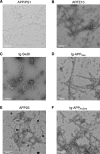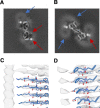Cryo-EM of Aβ fibrils from mouse models find tg-APPArcSwe fibrils resemble those found in patients with sporadic Alzheimer's disease
- PMID: 37973869
- PMCID: PMC10689242
- DOI: 10.1038/s41593-023-01484-4
Cryo-EM of Aβ fibrils from mouse models find tg-APPArcSwe fibrils resemble those found in patients with sporadic Alzheimer's disease
Abstract
The use of transgenic mice displaying amyloid-β (Aβ) brain pathology has been essential for the preclinical assessment of new treatment strategies for Alzheimer's disease. However, the properties of Aβ in such mice have not been systematically compared to Aβ in the brains of patients with Alzheimer's disease. Here, we determined the structures of nine ex vivo Aβ fibrils from six different mouse models by cryogenic-electron microscopy. We found novel Aβ fibril structures in the APP/PS1, ARTE10 and tg-SwDI models, whereas the human type II filament fold was found in the ARTE10, tg-APPSwe and APP23 models. The tg-APPArcSwe mice showed an Aβ fibril whose structure resembles the human type I filament found in patients with sporadic Alzheimer's disease. A detailed assessment of the Aβ fibril structure is key to the selection of adequate mouse models for the preclinical development of novel plaque-targeting therapeutics and positron emission tomography imaging tracers in Alzheimer's disease.
© 2023. The Author(s).
Conflict of interest statement
L.N.G.N. is on the scientific advisory board and receives a research grant from BioArctic. M.I. is a paid consultant to BioArctic. D.W. is a founder and shareholder of the company Priavoid and a member of its supervisory board. D.W. is co-inventor of patents related to the compound RD2. D.W. is a founder and shareholder of attyloid. D.W. is a member of attyloid’s supervisory board. These had no influence on the interpretation of the data. Benedikt Frieg is now an AstraZeneca employee. All other authors declare no competing interests.
Figures








Similar articles
-
Cryo-EM structure and polymorphism of Aβ amyloid fibrils purified from Alzheimer's brain tissue.Nat Commun. 2019 Oct 29;10(1):4760. doi: 10.1038/s41467-019-12683-8. Nat Commun. 2019. PMID: 31664019 Free PMC article.
-
The Arctic Alzheimer mutation facilitates early intraneuronal Abeta aggregation and senile plaque formation in transgenic mice.Neurobiol Aging. 2006 Jan;27(1):67-77. doi: 10.1016/j.neurobiolaging.2004.12.007. Epub 2005 Feb 17. Neurobiol Aging. 2006. PMID: 16298242
-
Longitudinal amyloid imaging in mouse brain with 11C-PIB: comparison of APP23, Tg2576, and APPswe-PS1dE9 mouse models of Alzheimer disease.J Nucl Med. 2013 Aug;54(8):1434-41. doi: 10.2967/jnumed.112.110163. Epub 2013 Jul 5. J Nucl Med. 2013. PMID: 23833271
-
Vaccines for Alzheimer's disease: how close are we?CNS Drugs. 2003;17(7):457-74. doi: 10.2165/00023210-200317070-00001. CNS Drugs. 2003. PMID: 12751917 Review.
-
Modulation of β-Amyloid Fibril Formation in Alzheimer's Disease by Microglia and Infection.Front Mol Neurosci. 2020 Nov 26;13:609073. doi: 10.3389/fnmol.2020.609073. eCollection 2020. Front Mol Neurosci. 2020. PMID: 33324164 Free PMC article. Review.
Cited by
-
Molecular Therapeutics in Development to Treat Alzheimer's Disease.Mol Diagn Ther. 2025 Jan;29(1):9-24. doi: 10.1007/s40291-024-00738-6. Epub 2024 Sep 24. Mol Diagn Ther. 2025. PMID: 39316339 Free PMC article. Review.
-
Cryo-EM structures of cotton wool plaques' amyloid β and of tau filaments in dominantly inherited Alzheimer disease.Acta Neuropathol. 2024 Aug 15;148(1):20. doi: 10.1007/s00401-024-02786-y. Acta Neuropathol. 2024. PMID: 39147931 Free PMC article.
-
Lecanemab Binds to Transgenic Mouse Model-Derived Amyloid-β Fibril Structures Resembling Alzheimer's Disease Type I, Type II and Arctic Folds.Neuropathol Appl Neurobiol. 2025 Jun;51(3):e70022. doi: 10.1111/nan.70022. Neuropathol Appl Neurobiol. 2025. PMID: 40495448 Free PMC article.
-
Unraveling Alzheimer's complexity with a distinct Aβ42 fibril type and specific AV-45 binding.Nat Chem Biol. 2025 Jun 10. doi: 10.1038/s41589-025-01921-4. Online ahead of print. Nat Chem Biol. 2025. PMID: 40494975
-
Cryo-EM structures of pathogenic fibrils and their impact on neurodegenerative disease research.Neuron. 2024 Jul 17;112(14):2269-2288. doi: 10.1016/j.neuron.2024.05.012. Epub 2024 Jun 3. Neuron. 2024. PMID: 38834068 Free PMC article. Review.
References
MeSH terms
Substances
Grants and funding
LinkOut - more resources
Full Text Sources
Medical
Molecular Biology Databases
Miscellaneous

